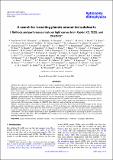A search for transiting planets around hot subdwarfs : I. Methods and performance tests on light curves from Kepler, K2, TESS, and CHEOPS
Abstract
Context. Hot subdwarfs experienced strong mass loss on the red giant branch (RGB) and are now hot and small He-burning objects. These stars constitute excellent opportunities for addressing the question of the evolution of exoplanetary systems directly after the RGB phase of evolution. Aims. In this project we aim to perform a transit survey in all available light curves of hot subdwarfs from space-based telescopes (Kepler, K2, TESS, and CHEOPS) with our custom-made pipeline SHERLOCK in order to determine the occurrence rate of planets around these stars as a function of orbital period and planetary radius. We also aim to determine whether planets that were previously engulfed in the envelope of their red giant host star can survive, even partially, as a planetary remnant. Methods. For this first paper, we performed injection-and-recovery tests of synthetic transits for a selection of representative Kepler, K2, and TESS light curves to determine which transiting bodies in terms of object radius and orbital period we will be able to detect with our tools. We also provide estimates for CHEOPS data, which we analyzed with the pycheops package. Results. Transiting objects with a radius ≤ 1.0 R⊕ can be detected in most of the Kepler, K2, and CHEOPS targets for the shortest orbital periods (1 d and shorter), reaching values as low as ∼0.3 R⊕ in the best cases. Sub-Earth-sized bodies are only reached for the brightest TESS targets and for those that were observed in a significant number of sectors. We also give a series of representative results for larger planets at greater distances, which strongly depend on the target magnitude and on the length and quality of the data. Conclusions. The TESS sample will provide the most important statistics for the global aim of measuring the planet occurrence rate around hot subdwarfs. The Kepler, K2, and CHEOPS data will allow us to search for planetary remnants, that is, very close and small (possibly disintegrating) objects.
Citation
Van Grootel , V , Pozuelos , F J , Thuillier , A , Charpinet , S , Delrez , L , Beck , M , Fortier , A , Hoyer , S , Sousa , S G , Barlow , B N , Billot , N , Dévora-Pajares , M , Østensen , R H , Alibert , Y , Alonso , R , Anglada Escudé , G , Asquier , J , Barrado , D , Barros , S C C , Baumjohann , W , Beck , T , Bekkelien , A , Benz , W , Bonfils , X , Brandeker , A , Broeg , C , Bruno , G , Bárczy , T , Cabrera , J , Cameron , A C , Charnoz , S , Davies , M B , Deleuil , M , Demangeon , O D S , Demory , B-O , Ehrenreich , D , Erikson , A , Fossati , L , Fridlund , M , Futyan , D , Gandolfi , D , Gillon , M , Guedel , M , Heng , K , Isaak , K G , Kiss , L , Laskar , J , Lecavelier Des Etangs , A , Lendl , M , Lovis , C , Magrin , D , Maxted , P F L , Mecina , M , Mustill , A J , Nascimbeni , V , Olofsson , G , Ottensamer , R , Pagano , I , Pallé , E , Peter , G , Piotto , G , Plesseria , J-Y , Pollacco , D , Queloz , D , Ragazzoni , R , Rando , N , Rauer , H , Ribas , I , Santos , N C , Scandariato , G , Ségransan , D , Silvotti , R , Simon , A E , Smith , A M S , Steller , M , Szabó , G M , Thomas , N , Udry , S , Viotto , V , Walton , N A , Westerdorff , K & Wilson , T G 2021 , ' A search for transiting planets around hot subdwarfs : I. Methods and performance tests on light curves from Kepler , K2, TESS, and CHEOPS ' , Astronomy and Astrophysics , vol. 650 , A205 . https://doi.org/10.1051/0004-6361/202140381
Publication
Astronomy and Astrophysics
Status
Peer reviewed
ISSN
0004-6361Type
Journal article
Description
A.C.C. and T.G.W. acknowledge support from STFC consolidated grant number ST/M001296/1.Collections
Items in the St Andrews Research Repository are protected by copyright, with all rights reserved, unless otherwise indicated.

